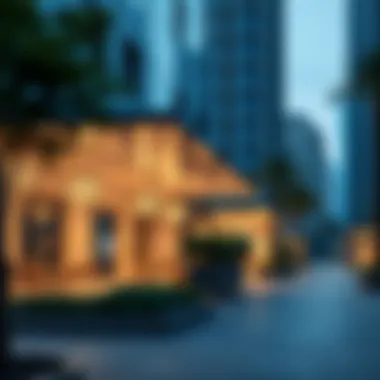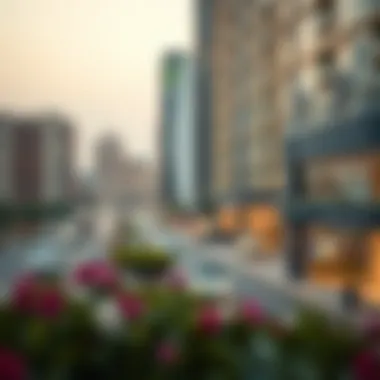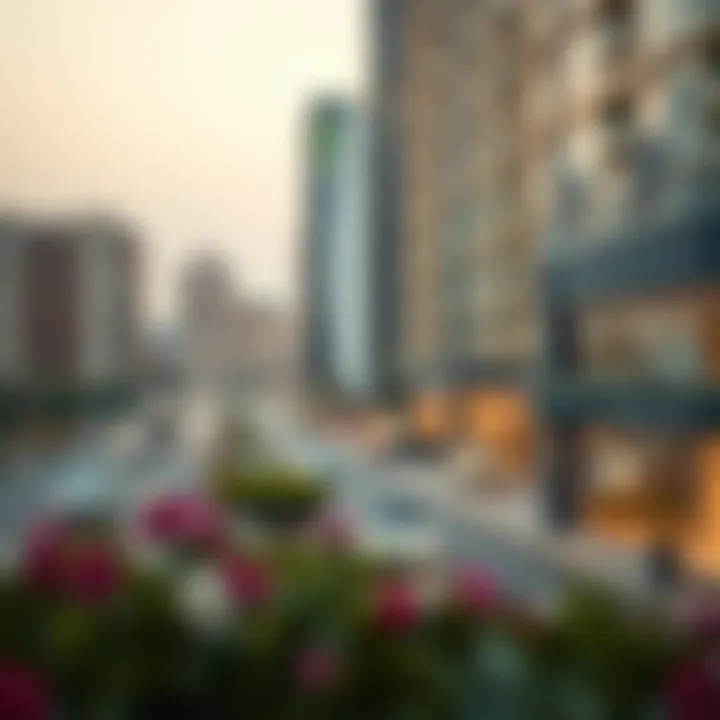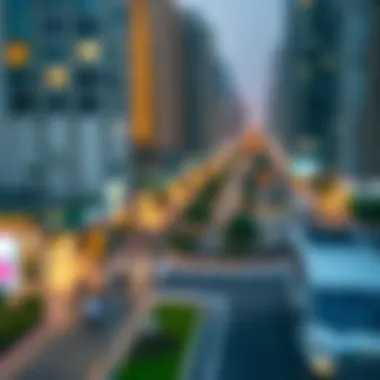Partitioning Insights Near Burjuman Metro in Dubai


Intro
The city of Dubai, with its blend of modernity and tradition, has transformed massively over the past few decades. One of the bustling hubs that epitomizes this dynamic change is the area surrounding the Burjuman Metro station. Partitioning, in urban development, carries implications far reaching into community life and real estate trends, and in Burjuman, this is particularly evident. As new partitions enter the scene, they not only reshape the physical landscape but also redefine the social fabric of the area.
Understanding how these splits affect both urban design and investment opportunities is vital for investors, homeowners, and real estate agents alike. This article dives into the intricacies of partitioning near Burjuman Metro, analyzing how it affects local dynamics and market trends, while also shedding light on potential investment avenues.
Market Trends
Current Real Estate Landscape
The real estate market in the vicinity of Burjuman Metro has seen a transformation that reflects broader economic trends in Dubai. The area's appeal lies in its strategic location, offering seamless access to various sectors of the city. With the rise of partitioning, the local real estate landscape has adapted to address the needs of an expanding community. Developers are keen to capitalize on this trend, creating mixed-use properties that cater to both residential and commercial requirements.
Moreover, the interplay of culture and commerce in this region attracts a diverse demographic. Consequently, the demand for upscale apartments and retail spaces has surged, placing Burjuman at a pivotal point in the urban development narrative of Dubai.
Property Price Trends
As the local economy wades through phases of growth, property prices in Burjuman have been on an upward trajectory, although it can be a mixed bag. From thriving studios to luxurious penthouses, the price variation hinges on several factors, including the proximity to the metro station and the nature of local amenities.
- Affordability: Newer partitions can increase housing supply, eventually stabilizing prices.
- Investment Viability: More competitive pricing can be found in developments right next to the metro, especially if they appeal to first-time buyers or investors looking for rental yields.
Overall, it’s clear that current trends in the real estate market are significantly influenced by partitioning dynamics, as new properties join the fray while older ones adapt to the evolving landscape.
"The real estate market is like a game of chess; every move, such as a new partition or development, can change the board drastically."
Investment Opportunities
High-Return Areas
For discerning investors, identifying hotspots is key to maximizing returns. The Burjuman area offers several high-potential zones where smart investments can yield impressive results. The proximity to the Burjuman Metro station is a considerable factor contributing to increased foot traffic and demand from both locals and expatriates.
Key areas worth noting include:
- Al Mankhool Road: This road has become a popular choice for business and retail developments, attracting both consumer attention and investor interest.
- Oud Metha: A cocktail of residential communities and commercial establishments, it also benefits from excellent connectivity.
Upcoming Developments
The future looks promising too, as several planned developments aim to enhance the area’s appeal and usability. These projects are not just buildings but a vision for community-centric living.
Investors should keep their eyes peeled for:
- Community Parks: Spaces designed for leisure and recreation that can offer added value to residential properties.
- New Office Towers: With business on the rise, office spaces anticipated around Burjuman are likely to entice corporations looking for a strategic base.
When considering investments in Burjuman, special attention to upcoming projects can pave the way for strategic advantages, providing long-term gains in terms of both rental yields and market appreciation.
Culmination
As partitioning revamps the Burjuman locale, the implications stretch beyond mere bricks and mortar. While the real estate landscape evolves and market trends emerge, the investment opportunities that unfold are ripe for exploration. Understanding the nuance of these changes can aid stakeholders in navigating the complexities of Dubai's vibrant urban tapestry. Investors, homeowners, and real estate professionals are thus encouraged to keep a watchful eye on this evolving neighborhood, for within its bounds lies the potential for significant growth and prosperity.
Prelude to Burjuman Metro Area
The Burjuman Metro area holds a vital position within Dubai’s bustling urban environment. Its significance stretches far beyond just being a hub of transportation; it encapsulates a blend of history, culture, and economic potential. Understanding this area is essential for investors, homeowners, agents, and analysts alike, as it connects to broader patterns in real estate and urban development.
Historical Context
To truly grasp the essence of Burjuman, one must first consider its historical backdrop. This location has evolved significantly over the past decades. Originally known for traditional markets and smaller shops, the advent of the Dubai Metro saw a transformation. The Burjuman station, which opened in 2006, catalyzed rapid development. This brought forth not only commercial giants like Burjuman Centre but also a bigger residential community.
From a quaint area with narrow lanes to today's bustling commercial centre, the change is striking. Understanding this trajectory is crucial for those analyzing property values or looking into future investments, as it reveals the adaptive nature of urban spaces in response to transportation links.


Current Economic Landscape
Today, the economic landscape near Burjuman Metro is a microcosm of Dubai’s broader trends. With a mixture of retail, hospitality, and residential projects, the area is thriving. Notably, the proximity to the metro line enhances accessibility, which is a key driver for both businesses and residents.
Key Economic Elements:
- Retail Boom: Burjuman Centre and surrounding malls have collections of international and local brands, capitalizing on foot traffic from the metro users.
- Residential Demand: The area sees a diverse demographic with a strong demand for housing, from premium offerings to more affordable units, reflecting the broader economic mix of Dubai.
- Investment Hotspot: For investors, Burjuman presents a rich tapestry of opportunities. With ongoing developments and favorable regulatory frameworks, this space continues to attract both local and foreign investments.
Understanding the nuances of the current economic landscape around Burjuman Metro opens doors for strategic investment decisions and identifies upcoming trends that could shape the future of the area.
"The key to successful investing is to understand the heartbeat of the market, and Burjuman’s evolution showcases just that."
When we dissect the dynamics at play near Burjuman Metro, we're not merely looking at real estate; we're uncovering layers of socioeconomic change that echo throughout Dubai.
The Concept of Partitioning
Partitioning is a vital facet of urban development, particularly near bustling hubs like Burjuman Metro in Dubai. This concept does not merely concern land division; it plays a crucial role in shaping urban landscapes, influencing real estate values, and impacting community interaction. Understanding partitioning allows us to appreciate its multifaceted benefits, along with the various considerations that should be taken into account.
Definition and Purpose
At its core, partitioning refers to the legal and technical process of dividing land into separate lots. Often employed to optimize land usage, it can lead to more efficient residential or commercial developments.
The purpose of partitioning extends beyond mere subdivision. It aims to enhance property value, facilitate better land management, and promote a more organized urban environment. For instance, a landowner might partition a larger plot to create several smaller lots for sale or lease, maximizing profit while catering to the demands of a growing population.
Moreover, partitioning can drive urban design innovation by enabling varied land use. In a rapidly developing area like Burjuman, partitioning encourages mixed-use development, where residential, commercial, and recreational spaces coexist harmoniously. This leads to a vibrant community atmosphere, fostering social interaction and economic opportunities.
Important Consideration: The process of partitioning is not merely technical but inherently social, influencing how communities interact and develop over time.
Legal Framework Governing Partitioning
The legal aspects of partitioning are paramount for ensuring that developments adhere to local regulations and urban planning standards. In Dubai, the land department and other governmental bodies oversee the subdivision processes, ensuring that property division follows legal protocols. These regulations often encompass zoning laws, environmental assessments, and the rights of existing land use.
Understanding the legal framework is crucial for investors and property owners. It dictates the permissible density, the types of developments allowed, and potential restrictions. For example, if a landowner wishes to partition their property into multiple residential units, they must understand how zoning laws dictate what can be built and where.
Not addressing these legalities can result in significant challenges. Investors may encounter regulatory hurdles, potentially leading to delays or financial losses. Therefore, it is critical to engage with local experts and legal advisors to navigate these complexities effectively.
Real Estate Dynamics Near Burjuman
The real estate landscape around Burjuman Metro is a reflection of both the city's growth ambitions and the ongoing transformation of urban spaces in Dubai. Understanding these dynamics is essential for investors, homeowners, real estate agents, and analysts looking to navigate this complex market. As the area continues to evolve, it presents both challenges and opportunities that require careful consideration.
Current Market Trends
Market trends in Burjuman are influenced by a mix of economic stability and sociocultural shifts. Here are some key observations:
- Growing Demand for Residential Units: There has been a noticeable uptick in the demand for residential properties, particularly in multi-family structures. With the influx of expatriates and the stable job market, developers are keen on constructing more apartment complexes.
- Commercial Spaces on the Rise: As the Burjuman area sees an increase in foot traffic due to the metro station, commercial real estate is experiencing a resurgence. Retail outlets, restaurants, and cafes are popping up, cementing Burjuman as a central hub for both locals and tourists.
- Sustainability Integration: Developers are increasingly focusing on sustainability practices, whether through eco-friendly materials or energy-efficient designs. This trend is not only a response to global demands but also aligns with the UAE’s Vision 2021, aiming for a sustainable future.
- Price Fluctuations: The price of properties in Burjuman can be inconsistent, influenced by various factors such as economic conditions, investor confidence, and regulatory changes. Keeping an eye on these fluctuations is critical for anyone looking to make a purchase.
"Burjuman is a crossroads of opportunity, where residential and commercial prospects intertwine, fostering a vibrant urban fabric."
Investment Opportunities
When it comes to investment around Burjuman, the area offers a variety of avenues worth exploring:
- Residential Development: With the high demand for housing, investing in residential compounds can yield consistent returns. Experts recommend considering units that cater to families, given the demographic trends.
- Commercial Ventures: The growing populace and surge in consumer interest provide a fertile ground for retail and hospitality businesses. Establishing a restaurant or shop in this vicinity can be particularly rewarding, as foot traffic remains high throughout the day.
- Mixed-Use Developments: Given the rising interest in convenience and community-centric living, mixed-use developments that incorporate both residential and retail spaces are on the rise. This approach not only maximizes space utility but also attracts a varied clientele.
- Flip Opportunities: For savvy investors, flipping properties can be a lucrative option. With some properties needing renovations or cosmetic upgrades, a strategic flip can reap substantial profits.
Benefits of Partitioning
Partitioning, particularly in the dynamic area near Burjuman Metro, holds significant benefits that resonate not only with property owners but also investors and stakeholders in urban development. Understanding these advantages can pave the way for strategic decisions that enhance real estate value and contribute to sustainable urban growth.
Enhancing Property Value


One vital benefit of partitioning is its ability to enhance property value. When large tracts of land are divided into smaller, more manageable parcels, it allows for more precise targeting of the market. For instance, a property that once sat unimproved might become a glowing landmark if partitioned wisely. This not only makes the properties more appealing to potential buyers, but also increases the competitive vitality of the market.
When properties are partitioned, each segment can more accurately reflect its market potential. Take, for instance, a historical building that is divided into several avenues—say for commercial and residential use. This allows for a broader range of price points and potential buyers. Thus, investors see a substantial upturn in their bottom line:
- Increased Demand: Smaller properties, especially those with distinct features, often generate greater competition among buyers.
- Improved Use of Space: Dividing land enables better design and utilization of resources, allowing for mixed-use developments that draw interest.
- Marketability: Unique segments tailored to specific buyer demographics can command higher prices and facilitate quicker sales.
Facilitating Urban Development
Partitioning serves as a catalyst for urban development, transforming how communities engage with infrastructure and amenities. The practices surrounding this are subtle yet impactful, shaping not just the physical landscape, but the social fabric in which these neighborhoods exist.
Consider that partitioning projects have been associated with regeneration initiatives, which often breathe new life into stagnant urban areas. Projects that follow this lead frequently share common threads:
- Enhanced Infrastructure: With partitioning comes the necessity for updated roads, transportation, and utilities, leading to overall improvements in the urban experience.
- Diversified Development: Different parties can visualize and execute diverse designs and purposes, from residential to commercial or community spaces.
- Inclusive Community Dynamics: As developers create spaces that attract various demographics, such as young professionals or families, they inevitably promote social harmony and inclusivity.
Moreover, from a governance perspective, partitioning supports strategic planning by allowing city authorities to better allocate resources and design spaces that fulfill community needs.
"Partitioning not only reshapes land but redefines community interactions, driving forward a vision of growth that uplifts everyone involved."
In summary, the benefits of partitioning in the Burjuman Metro area contribute significantly to real estate value and urban development. By increasing property desirability and facilitating essential city growth strategies, partitioning ultimately resonates deeply with stakeholders looking to invest in Dubai's vibrant future. The future of urban planning grows clearer amidst these developments, presenting exciting avenues for engagement and investment.
Challenges Associated with Partitioning
Understanding the challenges of partitioning is critical for any stakeholders actively engaging with real estate near Burjuman Metro. As investors, homeowners, and analysts look to navigate this landscape, they must contend with a host of obstacles, including regulatory hurdles and community sentiments. These challenges do not merely pose setbacks; they can significantly influence the overall feasibility and desirability of projects involving partitioning. Examining these hurdles equips potential investors with a robust framework for making informed decisions.
Regulatory Hurdles
When discussing partitioning, one can’t escape the layers of legal and regulatory procedures that come into play. In Dubai, the local governing regulations can be as intricate as a fine tapestry, weaving together a multitude of factors. Each partitioning project must comply with specific zoning laws, property rights, and building codes which are set to safeguard community interests and urban planning integrity. Often, developers and investors find themselves entangled in bureaucratic procedures, sometimes leading to delays in project approvals.
For instance, the Real Estate Regulatory Agency (RERA) in Dubai oversees the legitimacy of all real estate transactions and partitioning requests. Insufficient knowledge of these regulations can leave stakeholders in a quagmire.
Broadly speaking, many developers endeavor to navigate these regulatory minefields unscathed, yet often find themselves facing unexpected requirements—such as environmental assessments—that can complicate or even halt projects. Here are some key regulatory aspects:
- Zoning Permits: Compliance with land-use regulations is non-negotiable. Misinterpretation can lead to costly penalties.
- Building Codes: Any new partition must adhere to strict construction standards.
- Environmental Regulations: Approval processes can involve assessments that delay timelines.
Ultimately, stakeholders need to be well-informed, ensuring they consult with local experts who can streamline the partitioning process. This knowledge is not just helpful—it’s vital for avoiding unnecessary roadblocks.
Community Resistance
The societal aspect of partitioning near Burjuman cannot be overstated. Community resistance can arise from various dimensions—cultural sentiments, fear of disruption, or even skepticism about the benefits of partitioning. People tend to be pretty protective of their neighborhoods; they don’t like having their backyard turned into a construction zone. Additionally, when different groups within a community have opposing views on a partitioning project, the resulting friction can create significant barriers to advancement.
In some cases, local resident associations take a stand against perceived encroachments, leading to protests or calls for public consultations. These reactions may stem from broader concerns about changes in property values or a possible shift in the community's demographic profile.
To address community concerns, developers often engage in active dialogue, employing strategies like:
- Informational Workshops: Educating residents about the intended benefits can reduce fears.
- Feedback Mechanisms: Surveys or forums permit residents to voice their opinions, fostering a sense of inclusiveness.
- Collaboration with Local Leaders: Building alliances with community figures can temper resistance and facilitate better acceptance.
Engagement becomes a two-way street. Acknowledging and respecting community perspectives before initiating partitioning can pave the way for smoother project execution. After all, a project that holds the community’s favor stands a greater chance of success.
Community Impact of Partitioning
Partitioning holds significant sway over the community dynamics around Burjuman Metro. It's not just a technicality in real estate; this practice translates to tangible effects on everyday life, significantly influencing demographics, socioeconomic factors, and cultural interactions. Understanding these impacts is vital for investors, homeowners, and even local authorities, as it provides an insider's view of the community fabric.
Demographics and Socioeconomic Factors
When examining the demographics surrounding Burjuman, it’s essential to recognize the diverse melting pot that characterizes this area. This locality is home to various ethnic groups, each bringing unique traditions and expectations to the neighborhood. The demographic shifts resulting from partitioning are noteworthy; as properties are subdivided, they tend to attract a mix of buyers, from affluent individuals seeking luxury amenities to middle-class families looking for affordable housing options.
Such a mix influences socioeconomic factors significantly. For instance, as new apartments and shops crop up, there’s often an increase in job opportunities. Local businesses thrive with the influx of new residents, thereby creating a circular flow of economic activity. Investors should note that understanding these demographic shifts can lead to more informed investment strategies, aligning with the emerging community needs.
Moreover, the proportion of younger residents in the area has been steadily climbing. This influx results in a demand for amenities that cater to younger lifestyles, such as cafes, co-working spaces, and cultural venues. All of these factors contribute to a vibrant, diversified neighborhood that continuously evolves, which should not be overlooked in investment planning.


Cultural Dynamics
Cultural dynamics in the Burjuman area are intricately woven into the fabric of its partitioning strategy. As properties change hands and physical spaces transform, the underlying cultural scene tends to shift as well. New businesses often reflect the tastes of the residents, contributing to a unique blend of local and global influences. Old shops sometimes give way to modern enterprises that cater to a more cosmopolitan taste, and this has its pros and cons.
For instance, while newer establishments may cater to more diverse culinary tastes, long-standing businesses risk being overshadowed. This dual-edged sword can lead to tension within the community. Nevertheless, it also has the potential to foster unique cultural experiences that attract not only residents but also tourists, which can ultimately benefit local economies.
It's also vital for investors to grasp these cultural nuances. Engaging with the local community and understanding social values can empower them to make responsible and ethical investment decisions. This connection nurtures community trust and can enhance the brand image of any business or real estate venture in the area.
The intertwining of community dynamics and partitioning serves as a reminder that real estate is not merely about buildings, but about the people and cultures that inhabit them.
The community impact of partitioning near Burjuman extends beyond numbers and transactions; it's a living, breathing aspect of urban life that sets the stage for sustainable development and enhanced quality of life.
Future Prospects for Partitioning Near Burjuman
The examination of partitioning near Burjuman Metro offers insights not just relevant to the current landscape but also hints at future possibilities. This area, with its dynamic urban environment, stands at a crossroads of change, providing ample room for development. As we delve into the future prospects, it is crucial to consider the trajectories of both the real estate market and community dynamics that this form of urban planning entails.
Predicting Market Changes
Anticipating market changes involves looking into various economic indicators and patterns that emerge from the current state of real estate nearby Burjuman. Traditionally, areas surrounding metro stations tend to appreciate in value as they become increasingly desirable due to accessibility, convenience, and associated infrastructure improvements. With the rise of urbanization and a growing expat population in Dubai, the demand for residential and commercial space surrounding Burjuman is only expected to increase.
While fluctuations in the real estate market often hint at impending shifts, certain signs could indicate sustainability in growth. For instance:
- Increase in property transactions: A noticeable uptick in both rentals and sales shows investor confidence, which is generally a precursor for further economic health.
- Development of amenities: As new shops, parks, and public services emerge, property values naturally move upward.
- Government initiatives: Policies aimed at urban development can directly impact partitioning benefits, encouraging sustainable practices. Such initiatives often act as catalysts for long-term change.
As we look down the road, it becomes clear that the evolution of partitioning practices in Burjuman is tightly interwoven with these market changes. Investors and homeowners need to stay attuned to these trends to predict and capitalize on future opportunities.
Strategic Recommendations for Investors
For those considering an investment in partitioning near Burjuman, strategic planning is paramount. It's not just about acquiring property; it’s about understanding the broader picture and navigating the waters of urban development efficiently. Here are some tailored recommendations:
- Engage with Local Stakeholders: Establish bonds with local authorities, community businesses, and residents to stay ahead of changes in regulation and sentiment.
- Diversification of Investments: Consider investing in varied properties within the vicinity. By having a portfolio that includes both residential and commercial properties, one can mitigate risks associated with market fluctuations.
- Keep an Eye on Infrastructure Projects: With Dubai's continuous investment in infrastructure, don’t overlook nearby developments. These can lead to significant transformations in property value—stay proactive in scouting upcoming projects.
- Sustainability Focus: For future-proofing investments, consider properties that adhere to sustainable development principles. This is becoming increasingly appealing in an environmentally conscious market.
Sustainability Considerations
Sustainability has become a buzzword in recent years, yet its significance considerably escalates as urban areas, including those around the Burjuman Metro, grapple with unprecedented growth. Emphasizing sustainable practices is not merely an option but a necessity for long-term viability. The discussion around partitioning involves not just separating or dividing land but ensuring that this division promotes ecological balance, economic stability, and social harmony.
When one ponders partitioning in a bustling urban environment like Burjuman, the conversation naturally gravitates towards its environmental impact. More than merely slicing up land, partitioning can redefine how spaces interact with the environment. For instance, strategic separation of residential from commercial spaces helps in reducing noise pollution and enhancing air quality. The careful layout and design of properties can facilitate better water drainage systems, reducing flooding risks during rains, which helps preserve local ecosystems.
Another crucial angle is the value it ushers in through sustainable development practices. While partitioning by itself might appear as an act of division, it can also be a catalyst for nurturing sustainable communities. For example, adopting mixed-use developments within partitioned areas allows for more efficient land use and fewer vehicle emissions, as residents can often find amenities within walking distance. This type of urban planning not only conserves the environment but also infuses local economies with vitality.
Moreover, investors seeking to navigate the Burjuman landscape will benefit significantly by prioritizing sustainability in their evaluations. Properties that align with eco-friendly standards tend to attract a modern demographic that values green living. Understanding that sustainability influences property value is paramount for investors.
"Sustainable urban design is not just about green spaces; it's about creating healthy places where communities can thrive."
Ending
In wrapping up the intricate discussions regarding partitioning near Burjuman Metro, it's essential to reflect on several key elements that underline its significance. The impacts of partitioning extend beyond mere administrative decisions; they encapsulate social, cultural, and economic dimensions that resonate through the fabric of the Burjuman community.
Summary of Key Points
Throughout our exploration, we shed light on:
- Economic Implications: Partitioning can enhance property values and create attractive investment opportunities, rejuvenating the real estate market. Significant property ventures have emerged as more than just structures; they represent trading potential, generating profits for investors and stimulating the local economy.
- Community Dynamics: The challenges and advantages faced by the residents illustrate how partitioning shapes their daily life. Understanding demographic shifts and cultural landscapes helps stakeholders make informed decisions.
- Future Prospects: With projected urban changes and infrastructure plans, the Burjuman area is poised for growth. Investors must remain vigilant and adaptable to capitalize on these developments.
In essence, partitioning resonates through the region, influencing practices that touch various facets of life from economic prosperity to cultural identity. The opportunity for substantial growth leads us to its thoughtful consideration.
Final Thoughts on Future Developments
Looking ahead, the horizon for partitioning near Burjuman suggests a promising narrative intertwined with modern urban development. The successful orchestration of these processes hinges on effective collaboration between government bodies, investors, and community members.
Investors must navigate these evolving landscapes carefully. By keeping abreast of regulatory shifts and community sentiments, they can enhance their positions and secure profitable outcomes. Moreover, local governance will need to facilitate sustainable practices and address any resistance faced by inhabitants.
As we anticipate future urban transformations, the dialogue surrounding partitioning will continue to be relevant. The insights discussed here will serve as key reference points for stakeholders involved in investments, urban planning, and property management. An informed approach, coupled with active participation from all involved parties, can significantly forge a successful journey for the Burjuman region.
"The future belongs to those who believe in the beauty of their dreams to turn vision into reality."















